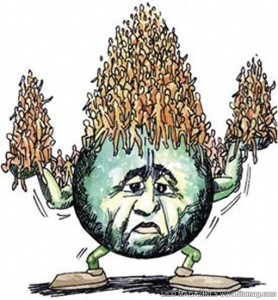 On October 31, 2011, the world’s population reached 7 billion people, according to projections produced by the United Nations Population Fund (UNFPA). This number is reached 13 years after the 6 billion mark, and 13 years before the 8 billion mark is projected to be reached. While this number is the outcome of a massive system of data collection and complex calculations, and is somewhat contested (see this NY Times story, for example), its production is not the focus of public discourse. Instead, not surprisingly, the flurry of media coverage and institutional pronouncements that surround this “momentous” event focus on the fact of 7 billion itself. Apart from its practices of construction, what does such a number mean for an STS audience? How can we read 7 billion?
On October 31, 2011, the world’s population reached 7 billion people, according to projections produced by the United Nations Population Fund (UNFPA). This number is reached 13 years after the 6 billion mark, and 13 years before the 8 billion mark is projected to be reached. While this number is the outcome of a massive system of data collection and complex calculations, and is somewhat contested (see this NY Times story, for example), its production is not the focus of public discourse. Instead, not surprisingly, the flurry of media coverage and institutional pronouncements that surround this “momentous” event focus on the fact of 7 billion itself. Apart from its practices of construction, what does such a number mean for an STS audience? How can we read 7 billion?
We can start with the UNFPA’s own report, in which the agency Director provides an odd formulation for a commemoration of a world population number:
So instead of asking questions like, “Are we too many?” we should instead be asking, “What can I do to make our world better?” or, “What can we do to transform our growing cities into forces for sustainability?” (State of the World Population 2011, ii)
7 billion is a Malthusian trope, an implied but highly contested narrative about the dangers of our population size. What is most striking to me is the way that this number has been co-opted from discussions of the crisis it implies, to discussions of the opportunities that arise from it. The crisis framing can no longer be part of the “polite society” of distinguished population institutions. Don’t get me wrong, there are still plenty of organizations and individuals out there willing to articulate Malthusian warnings: scarce resources growing ever more scarce; social and political insecurities promoted by the strains of human numbers; the explosion of the poor relative to the rich; or just too damn many people. But what is more striking is the small percentage of truly crisis framings a Google search of “7 billion people” turns up. This sort of crisis orientation, with its focus on population numbers, lost credibility in the mid 1990’s with a range of professional and lay critiques, from the left and the right. These critiques were institutionalized with the last population agreement negotiated in Cairo, and the population crisis orientation was further pushed from the international agenda in 2000 by the UN’s Millennium Development Goals.
Instead, the 7 billion mark provides a new “opportunity” to ask a range of more specific questions about global equality, urbanization, ageing populations, youth bulges, and environmental destruction. But how does the number, 7 billion, open an opportunity for complex global questions? It does so as, again, an un-narrated stand-in for crisis, limits to growth, environmental and civilizational collapse, and all the other Malthusian concerns that the number itself has come to narrate.
Perhaps the most interesting and sustained attempt to take advantage of this opportunity is a year-long series of videos, publications, and images produced by National Geographic. Most widely circulated is their exploration of “The Face of 7 Billion” – a study of what the world “looks” like at the 7 billion mark. “Looks” here is partially figurative, but in its most gripping, is all too literal. Center stage is the figure of the “typical” person today. What does he look like? They are careful to find the “typical” and not the “average” human alive today – this is the mode, not the mean. He is 28 years old, male, and Han Chinese. You can see his picture in the video below. In twenty years his face will change, as he will be Indian. But, again, isn’t this an odd construct for this moment? Why explore the typical subject at the very moment of 7 billion people, as a response to that fact? Can we make sense of this just as a marketing ploy – a moment to take advantage of media attention while not actually entering the fray of the population question? Is it possible to present just an interesting set of facts about how the world looks, in the context of population growth and its history of fear and racism, without “seeing” the Chinese or Indian face as a commentary on race, wealth, security, and power? Can the opportunities that a focus on population growth affords, for dialog on global issues, ever be removed from its history of fear, inequality, and crisis?
Saul Halfon is an Assistant Professor in Virginia Tech’s Department of Science and Technology in Society. His research focuses on the political sociology of science and technology, especially the politics of demography and population, environmental politics and policy, the international politics of food and risk, and science and law.





